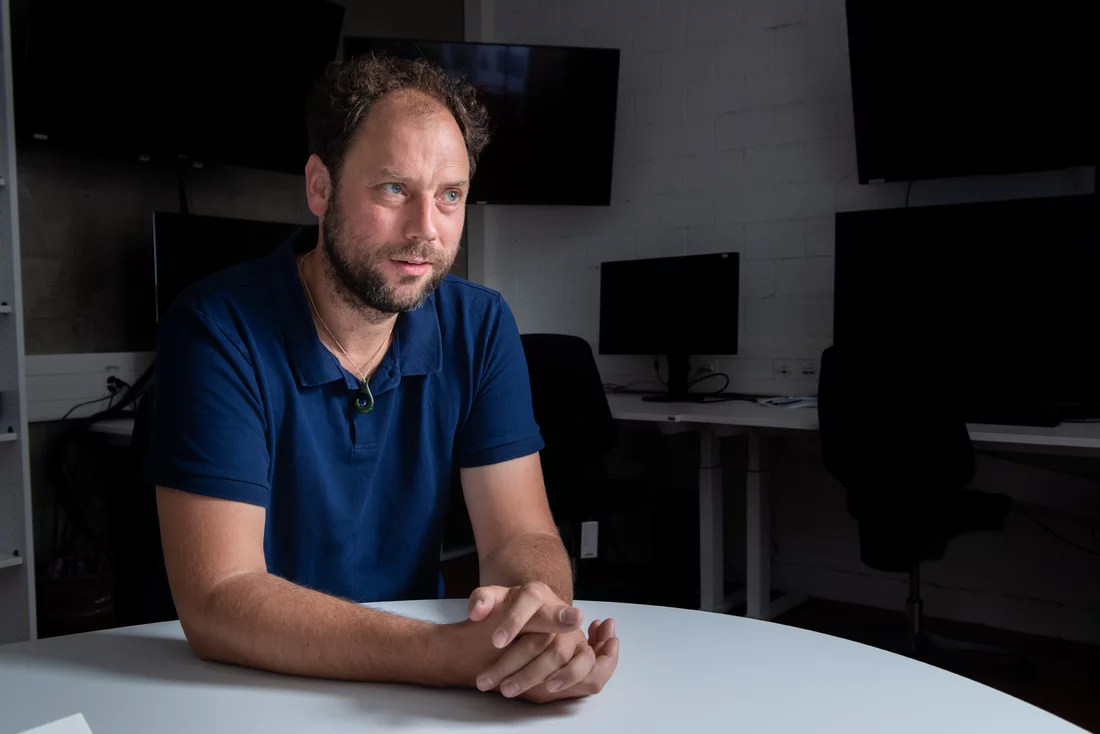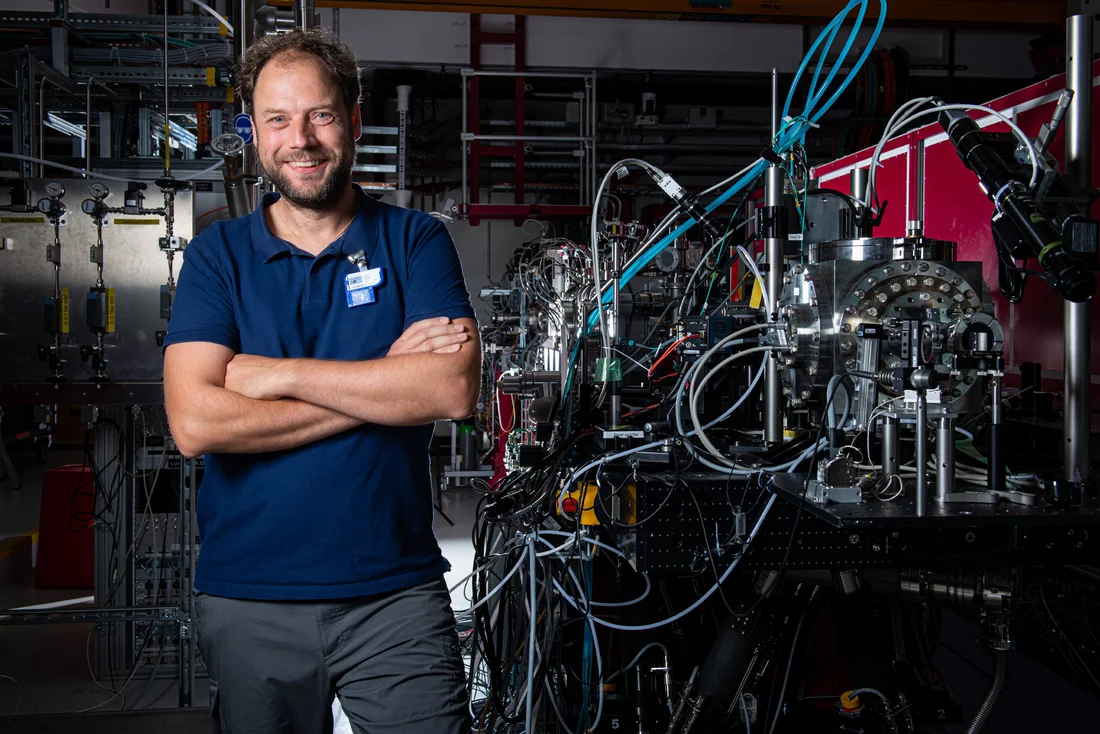The newest large research facility at the Paul Scherrer Institute, SwissFEL, has been completed. Regular operation began in January 2019. Henrik Lemke, head of the SwissFEL Bernina research group in the Photon Science Division, gives a first interm report.
Mr. Lemke, you have just published a technical article in which you report on the experience so far with SwissFEL. How would you sum it up?
With SwissFEL, we are entering new territory at PSI. It is one of only five comparable facilities on this scale worldwide. This means we still need to gain experience, because we are doing a lot of things for the first time. On January 1 this year we began regular operation. Research groups from other institutions have already been here, and they have successfully conducted experiments with us, just like PSI researchers themselves. These were already a big success. In parallel to this operation, we are also further optimising the facility and the experimental setup. This will enable us to join ranks with the comparable facilities and, in addition, develop particular methods into specialities of SwissFEL.
What are you optimising?
We're working, for example, on improving the X-ray pulses that SwissFEL provides for the experiments: We want to get a still higher energy and a shorter pulse duration, as well as a higher repetition rate, since we have not yet reached 100 percent of what's possible. We also optimise in order to achieve a higher temporal resolution that can be achieved with our measuring instruments. In early 2019 we carried out a PSI-specific experiment that helped us to improve the temporal resolution quite a bit.
In other words, you also conduct experiments that serve solely to optimise the facility?
Of course. These are so-called commissioning experiments. In these cases, we carry out a trial with a known result to test and improve the hardware and performance. In another category, there are pilot experiments in which we tackle a new scientific issue for the first time with the new capabilities of SwissFEL. At our experiment station Bernina, we had the very first pilot experiment at the end of 2017, and four more in 2018. These were all successful, and in the process we tried out very different techniques. On the basis of this experience, we opened up SwissFEL for regular operation at the start of 2019, this year: That means from now researchers from Switzerland and other countries are invited to conduct new tests at SwissFEL, the so-called user experiments.
The Bernina experiment station is named for the Graubünden Pass in the Alps. What kinds of scientific problems are investigated at SwissFEL's Bernina?
Our primary topic is materials research. We study new materials in which we can more precisely observe and control switching processes. For example, toggling between two quantum states. Stable states are often represented as valleys of energy, so the Bernina mountain pass symbolises the transition from one state-valley to another.
The fundamental idea in our research is often a potential application in the computers of the future or for data storage, which ultimately is based on selectively switching back and forth between specific material states. For example, one particular state can stand for zero, and another for one. Such switching operations are ultrafast. Facilities like SwissFEL offer, for the first time, a correspondingly ultrahigh temporal resolution for observing and investigating these switching mechanisms with X-rays.
Could you explain a bit more about the concept of quantum states?
Quanta is a term we use whenever states can only change stepwise. This is especially prevalent in the world of the very smallest, for example in the electron states in an atom, which can only switch back and forth between states of a specific energy. It's a bit like with a dice, which always shows integer numbers of dots – and never suddenly a value between 2 and 3.
Quantum states are very useful, for example, for information technology. However, it is rather difficult to exploit these quantum states in individual atoms, since the energy differences are very slight and therefore unstable.
In solids this is different: Here the atoms are packed together very tightly, typically in a crystal lattice. As a result, the individual quantum states can virtually merge together. Through a complex interplay, very interesting macroscopic quantum states can then arise. In this way, for example, certain materials undergo a transition to the state of superconductivity. Now a great many atoms are involved, which increases the energies needed to switch. These quantum states are thus more stable, and therefore much more interesting for potential applications.
So we investigate macroscopic quantum states of solids. In suitable materials, we selectively create or change quantum states with special short laser pulses. Immediately afterwards, we measure them with the ultrashort pulses of SwissFEL.
All of this has to go unimaginably fast to be able to map not only the respective initial and final states, but also the intermediate stages during the development or decay processes. These give us insight into the complex mechanism that stabilises a quantum state. And that is exactly the strength of SwissFEL: Here we can achieve the high temporal resolution that is necessary.
What is happening in the meantime at the other SwissFEL experiment stations?
There too the user operation has started. The Alvra beamline deals with chemical and biological questions, and as with us, ultrafast processes are measured. There, for example, it's possible to observe how proteins switch between the states of different biological functions.
In addition, construction is already under way on the third beamline, which is called Cristallina. One of the movable instruments we are currently using at Bernina will then be relocated to there: the SwissMX Setup. That stands for Swiss Macro Crystallography. Its special feature is a robotic arm that exchanges the sample every few minutes. At SwissFEL the beam is so intense that it destroys certain samples point by point. To put in a fresh, intact sample would take a person at least five minutes each time. The robotic arm, in contrast, does the same in 20 to 30 seconds. As a result, we are constantly making the most effective use possible of the valuable SwissFEL beamtime.
What else will be happening at SwissFEL in the course of 2019?
Right now, this is a very exciting year at SwissFEL. Everything that I've told you about so far is related to the Aramis beamline, with its three experiment stations Alvra, Bernina, and in the future Cristallina. Now the second source, called Athos, is being completed. While we at Aramis have so-called hard X-rays, SwissFEL will deliver soft X-rays at Athos. The first test of Athos is scheduled for the end of 2019.
Specifically, we in the Bernina group still have a lot in the works for this year: We want to conduct experiments at still colder temperatures. In other words, we want to routinely get below 20 or even 10 Kelvin, where zero Kelvin is absolute zero, minus 273 degrees Celsius.
In addition, we want to further increase the temporal resolution that we achieve with our experiments. Our current temporal resolution is around 100 femtoseconds. One femtosecond is a quadrillionth of a second. The temporal resolution indicates the time interval between two successive images in our virtual "movie", which makes the processes in the sample visible. A higher temporal resolution means making this time interval even smaller, which means achieving less femtoseconds. I think we can achieve around 50 femtoseconds by the end of 2019. Our ambitious goal for SwissFEL is to get it down below 10 femtoseconds.
Among other things, we are also optimising the software which can process our huge amounts of data as soon as they are generated. The researchers in Bernd Schmitt's group here at PSI build really phenomenal detectors, which make us the envy of the world. But one feature that comes with such quality is that these detectors produce an awful lot of data in a short time: up to several gigabytes per second! The data must be continuously "carried off" and processed, so that we don't end up with a data traffic jam. That requires enormously fast networks, as well as hardware and software that can process data effectively.
So examining samples and improving the experiment station go hand in hand?
Yes, you can put it that way. We've been doing new research of our own since the end of 2017, and in collaboration with external researchers since this year. But in parallel, at SwissFEL and at our Bernina, we will probably never stop tinkering.
Interview: Paul Scherrer Institute/Laura Hennemann
Contact
Dr. Henrik Lemke
Head of the SwissFEL Bernina Research Group
Paul Scherrer Institute, Forschungsstrasse 111, 5232 Villigen PSI, Switzerland
Telephone: +41 56 310 49 82, e-mail: henrik.lemke@psi.ch
Original publication
Experimental station Bernina at SwissFEL: condensed matter physics on femtosecond time scales investigated by X-ray diffraction and spectroscopic methods
G. Ingold, R. Abela, C. Arrell, P. Beaud, P. Böhler, M. Cammarata, Y. Deng, C. Erny, V. Esposito, U. Flechsig, R. Follath, C. Hauri, S. Johnson, P. Juranic, G. F. Mancini, R. Mankowsky, A. Mozzanica, R. A. Oggenfuss, B. D. Patterson, L. Patthey, B. Pedrini, J. Rittmann, L. Sala, M. Savoini, C. Svetina, T. Zamofing, S. Zerdanea, and H. T. Lemke
Journal of Synchrotron Radiation Volume 26, Part 3, May 2019, Pages 874-886
DOI: 10.1107/S160057751900331X


